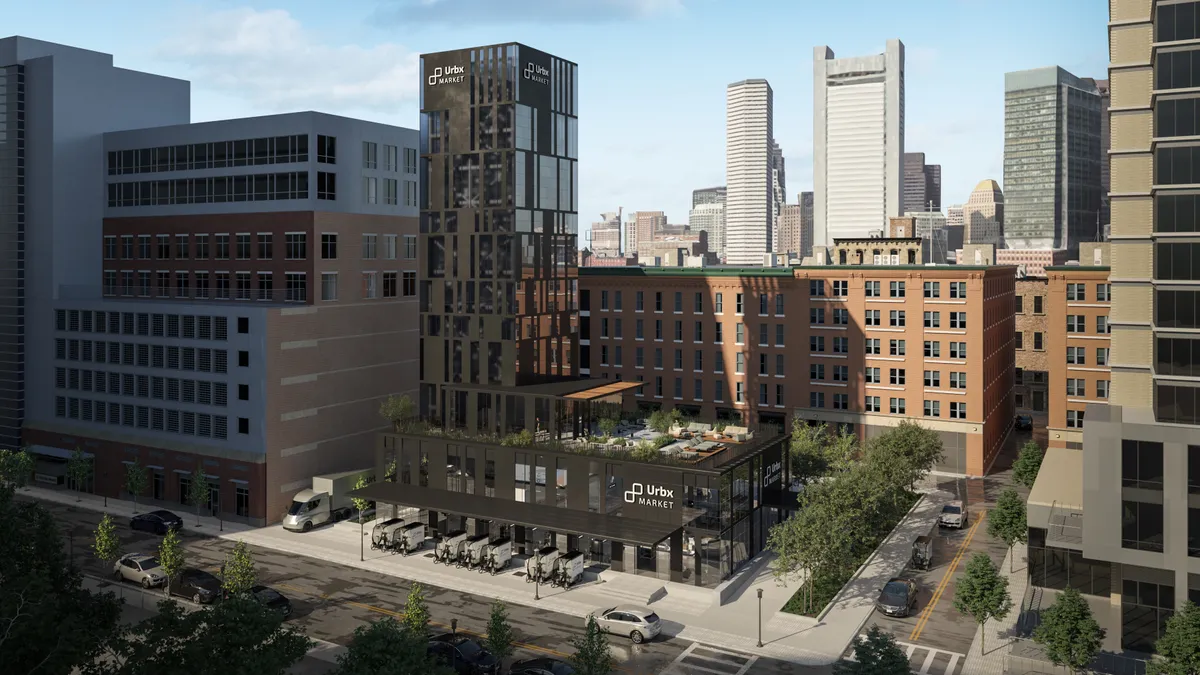Building a fully automated grocery store is certainly an eye-catching idea right now, but it’s also prohibitively expensive for most startups. In addition to pricey robotics and other hardware, real estate costs can balloon into the millions of dollars in urban neighborhoods that have the population density and income levels to support such a model.
That’s why Lincoln Cavalieri wants to build vertically. He’s the co-founder of Urbx, a startup that’s planning to build a grocery store with an automated fulfillment system attached to it that reaches up to 150 feet high and can squeeze into as little as 1,800 square feet of space.
Urbx Market, as it’s being called for now, will focus on filling e-commerce orders to the many consumers that live around its stores, the first of which is slated to be built in Boston by the end of next year. Pickup orders and e-bike deliveries will get orders to shoppers within an hour. There will also be a small storefront where shoppers can order using kiosks, or with their phones, and robots will bring their orders out to them within minutes. Order picking and packing will happen in a basement level, furthering the focus on vertical alignment.
Cavalieri said the store will cost between $5 million and $7 million to build — roughly the same cost to construct a Whole Foods, he said, but with lower real estate costs and higher e-commerce productivity.
"I think the whole process of how a grocery store is laid out is going to change significantly in the future, and it's going to be driven by e-commerce," he said.
Operating small, automated grocery fulfillment in a densely populated urban market isn’t a new concept. But being able to stack the hardware numerous stories high promises to alleviate at least some of the cost pressures that make urban e-commerce so tricky. Urbx’s system uses robots that travel vertically and horizontally along fixed tracks, and incorporates predictive picking software to optimize their routes.
The retail concept is similar to other “store of the future” projects like Alert Innovation's Novastore and Locai Solutions’ Omni-Store that combine e-commerce-focused automation with on-site shopping. One key difference with Urbx is that there won't be any product aisles to roam or service departments to visit.
Urbx hopes to eventually open thousands of urban markets. In the meantime, the company is focused on integrating its fulfillment technology with grocery retailers and scaling up as a service provider. Cavalieri said Urbx plans to announce pilots with a few grocers in the coming months along with Series A funding. The firm also plans to double its workforce of 10, which currently includes veterans from Amazon and iRobot.
Offering automated micro-fulfillment brings Urbx into an increasingly crowded field that includes Fabric, Takeoff Technologies, AutoStore, Dematic and other providers. Cavalieri said his company stands out with its vertical approach as well as speed of fulfillment. Its dual-robot system, which he likened to small elevators speeding along x and y axes, can retrieve a large order’s worth of goods in around two minutes. By the numbers, Cavalieri said Urbx’s system can retrieve 50 items in 135 seconds. The company's tower bots, which move vertically, travel at a max speed of 26 feet per second, while the grid bots, which move horizontally, max out at 13 feet per second.
Cavalieri said the company’s system, which incorporates chilled, frozen and ambient storage temperatures, works best in standalone locations as opposed to integrating into the back of a store.
Cavalieri said Urbx’s vertical approach to fulfillment was born out of necessity. He started the company with a vision for an Instacart-like concept that would offer last-mile fulfillment and storage of grocery products. The patch of real estate they targeted in Boston’s Back Bay area, however, was too small to hold all the items they wanted to carry. They knew they needed to build up.
“There wasn't a system out there that allowed us to go 100 feet in the air,” Cavalieri said.
In theory at least, Urbx’s omnichannel model is well-positioned for a post-pandemic world where e-commerce takes up a larger portion of grocery shopping but where consumers still want to venture to stores. It remains to be seen, though, if that same appeal holds true for a store that only offers shopping at kiosks, and that will face competition from the likes of Amazon Fresh, Target and other well-funded competitors also targeting urban markets.
For now, the company offers a futuristic model for urban retailing and fulfillment. And it comes as companies test out a variety of automated, unmanned service models, from pickup kiosks to driverless vehicle delivery.
"Over the next five to 10 years, there's going to be a pretty rapid transformation in terms of how we shop at grocery and big box retailers. I think the trend to automation is going to happen rather quickly, and I think it's going to be the dominant trend moving forward," Cavalieri said.
























